Thread states:
So far we have talked about starting and running threads and having access to the CPU in a very general way. What we need to do now is look at the various states that a thread can be in and how a thread might move from one state to another.
A thread is in one of five states at any moment in time. These are:
- initial state;
- runnable state;
- running state;
- blocked state;
- finished state.
Figure shows the possible transitions between states.
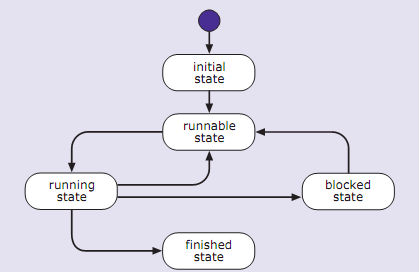
Figure: Thread states showing possible transitions
Movement from one state to another is governed by a number of methods which are inherited from the Thread class and the Object class, as well as by the operating system and other external factors. We have already met some of these methods, but there are others that we will use in order to make full use of threads.
These methods allow some control over which state a thread is in, although you must be aware that the operating system can also change the state of a thread and so your program must anticipate this possibility.
Figure shows a thread which is put into the initial state by means of it being created using new.
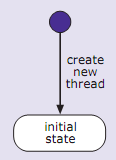
Figure: Transition to the initial state
In Figure, we see that the start method moves the thread into the runnable state. This does not mean that it will run immediately (there may be another thread that is being run by the CPU).
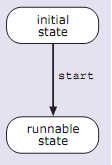
Figure: Transition from the initial state to the runnable state
At certain times during the execution of a program that contains threads, the Java system will have a look at all the runnable threads and will select one to execute (which one it selects is discussed later). Only the thread that is actually executing is said to be in the running state. This is shown in Figure.
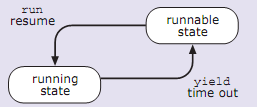
Figure Transitions between the runnable and running states
When a particular thread is chosen, its run method is invoked and the thread can begin to execute the code. It is now in the running state. When it finishes executing, it moves into the finished state. However, the code may not reach its conclusion before other events intervene. The thread may run out of its allotted CPU time, as represented by the time out label in Figure. Alternatively, it may invoke the yield method to give way to other threads of equal or higher priority. Both scenarios will cause the thread to go back into the runnable state where it can, at some point, be chosen by the Java run-time system to move back into the running state. Once it is back in the running state it can carry on with the execution of its run method at the point where it left off. This is indicated by the resume label in Figure.
We already mentioned that a thread in the running state may run to completion and hence enter the finished state. In Figure, we see that it is also possible that a running thread may enter the blocked state.
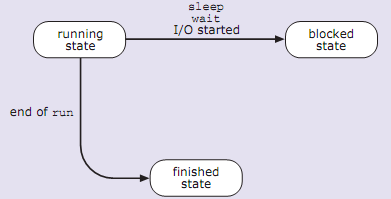
Figure: Transitions from the running state to the blocked and finished states
From the running state, a thread may move to the blocked state because of delays in I/O, or because the sleep method or wait method is invoked. The sleep method is a static method of Thread and so can be called in any program, even those that do not use the Thread class. When invoked, it puts the thread to sleep for the specified number of milliseconds.
In Figure, we see the transition from the blocked state to the runnable state.
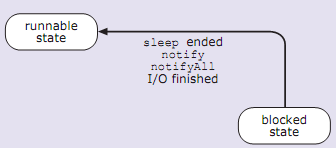
Figure: Transition from the blocked state to the runnable state
In the blocked state, the thread cannot progress until something happens - for example, an I/O transfer is completed. Note that from the blocked state the thread can move only into the runnable state to await being chosen by the Java run-time system to move into the running state.
Three of the methods that we have seen so far have not been discussed in any detail and they are wait, notify and notifyAll. All three methods are inherited from the Object class rather than the Thread class, and we will see why this is so later. Briefiy, the wait method causes a thread to wait for notification by another thread, and notify and notifyAll provide such notification. The situation is more complicated than this.
There are other ways of changing the state of a thread, and later in this unit we will describe them. The important concept at this stage is that a Java program may involve a number of threads, some of which are runnable and ready to be executed by a processor and others that are unable to proceed because they are blocked. On a single-processor machine only one thread can actually be running at a time. The Java system has a component known as the scheduler that makes decisions about which thread to run next. The decision as to when thread execution is switched will depend on the underlying operating system: some operating systems switch when the currently running thread becomes blocked, while others allocate set blocks of time to a thread.
Java Assignment Help - Java Homework Help
Struggling with java programming language? Are you not finding solution for your Thread states homework and assignments? Live Thread states experts are working for students by solving their doubts & questions during their course studies and training program. We at Expertsmind.com offer Thread states homework help, java assignment help and Thread states projects help anytime from anywhere for 24x7 hours. Computer science programming assignments help making life easy for students.
Why Expertsmind for assignment help
- Higher degree holder and experienced experts network
- Punctuality and responsibility of work
- Quality solution with 100% plagiarism free answers
- Time on Delivery
- Privacy of information and details
- Excellence in solving java programming language queries in excels and word format.
- Best tutoring assistance 24x7 hours